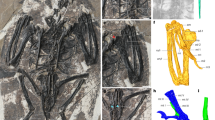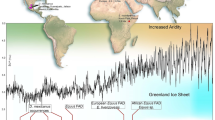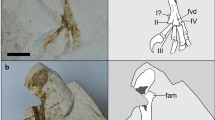Abstract
de Beer1 proposed that ostriches and their allies, the ratites, are degenerate birds that evolved, neotenously, from cannates (flying birds). Others2–5 have argued for their primitiveness, but the view that ratites are derived within birds has prevailed6–8. The problem is soluble only when avian phytogeny is understood, and Ostrom9 makes a strong case for the evolution of birds from theropod dinosaurs. Included in his evidence was the ascending process of the astragalus, a feature first shown by Huxley2 to be unique to theropods and birds (Fig. 1). Ostrom's critics10, however, argue that the avian process is not associated with the astragalus, being instead an independent ossification, the pretibial bone11. The present ontogenetic study reveals both processes in birds: the ascending process exemplified by ratites and the pretibial bone by carinates. This implies that, since carinates possess the unique pretibial bone, they could not have given rise to the ratites, which are primitive for this feature.
This is a preview of subscription content, access via your institution
Access options
Subscribe to this journal
Receive 51 print issues and online access
$199.00 per year
only $3.90 per issue
Buy this article
- Purchase on Springer Link
- Instant access to full article PDF
Prices may be subject to local taxes which are calculated during checkout
Similar content being viewed by others
References
de Beer, G. Bull. Br. Mus. nat. Hist. Zool. 4, 59–70 (1956).
Huxley, T. H. Q. Jl Geol. Soc. 26, 12–31 (1870).
Lowe, P. R. Proc. zool. Soc. Land. 1928, 185–247 (1928).
Lowe, P. R. Ibis 5, 398–432 (1935).
Friant, M. Acta anat. 39, 300–328 (1959).
Bock, W. J. Proc. Int. orn. Congr. 13, 39–54 (1963).
Cracraft, J. Ibis 116, 494–520 (1974).
de Beer, G. in A New Dictionary of Birds (ed. Thomson, A. L.) 681–685 (Nelson, London, 1964),
Ostrom, J. H. Nature 242, 136 (1973); Ostrom, J. H. Q. Rev. Biol. 49, 27–47 (1974); Ostrom, J. H. A. Rev. Earth planet. Sci. 3, 55–57 (1975); Ostrom, J. H. Proc. Cent, natn. Rech. Sci. 218, 519–532 (1975); Ostrom, J. H. Biol. J. Linn. Soc. 8, 91–182 (1976).
Martin, L. D., Stewart, J. D. & Whetstone, K. N. Auk 97, 86–93 (1980).
Morse, E. S. Ann. Lyceum Nat. Hist. 10, 141–158 (1874).
Watson, A. G. Anat. Rec. 187, 743 (1977).
Parker, T. J. Phil. Trans. R. Soc. 182, 25–134 (1892).
Holmgren, N. Acta zool. Stockh. 14, 185–295 (1933); 36, 243–328 (1955).
Welles, S. P. J. Paleont. 59, 401 (1983).
McGowan, C. J. zool. Res. 197, 173–219 (1982).
Gingerich, P. D. Nature 243, 70–73 (1973).
Houde, P. & Olson, S. L. Science 214, 1236–1237 (1981).
McDowell, S. Auk 65, 520–549 (1948).
Tucker, B. W. Int. orn. Congr. 8, 222–224 (1938).
Author information
Authors and Affiliations
Rights and permissions
About this article
Cite this article
McGowan, C. Evolutionary relationships of ratites and carinates: evidence from ontogeny of the tarsus. Nature 307, 733–735 (1984). https://doi.org/10.1038/307733a0
Received:
Accepted:
Issue Date:
DOI: https://doi.org/10.1038/307733a0
This article is cited by
-
Bird embryos uncover homology and evolution of the dinosaur ankle
Nature Communications (2015)
-
Homologies in the avian tarsus
Nature (1985)
-
Homologies in the avian tarsus
Nature (1985)
-
Ratites as oldest offshoot of avian stem—evidence from α-crystallin A sequences
Nature (1984)
Comments
By submitting a comment you agree to abide by our Terms and Community Guidelines. If you find something abusive or that does not comply with our terms or guidelines please flag it as inappropriate.



